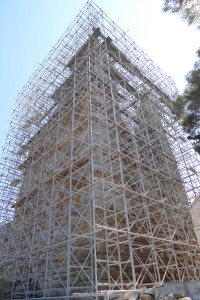
In 1884, the British adventurers Theodore and Mabel Bent visited Kea.
On March 29th 1884, the day before they left the island, Theodore and Mabel visited the ancient tower of Agia Marina. They were treated with such hospitality by the guardian of the former monastery. Theodore writes:
The people at the convent, the old man and his granddaughters, who till the ground around and look after the church, were most hospitably inclined, and provided us with an excellent mysethra , hot and fresh, for our midday meal, and we had the further charm of watching it made. They poured fresh goats’ milk into boiling whey and then squeezed it and compressed it into a wicker basket until it was compact and beautifully white, and then the honey of Hagia Marina was most excellent . . . As the wine flowed freely the old man became exceedingly talkative
Mabel adds in her chronicles:
We all . . . sat down at a very low table and had a very good luncheon with limited implements, which I’m sure I would not have enjoyed a year ago.
I decided to visit the tower to see what remains of the structure after Theodore’s dire predictions of its imminent collapse.
Driving down from Ioulidha toward Poisses, the valley stretches out below on the right and I couldn’t resist stopping to take pictures. “But what,” I thought, “is that monstrosity of a modern construction doing in such a rural setting, looking like some inner-city tower block.”
Further on down the road, the brown and yellow ‘antiquities‘ signpost to the tower was easy to spot on the bend, about halfway between the two towns. On my map it’s a white road, which can mean a rough track, but this one was fine and after 1.3 km I arrived in front of the monastery with the realisation that the eyesore I’d seen from high-up on the road was actually my destination!
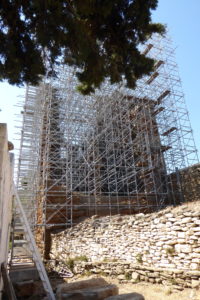
The tower is encased in a fine mesh of scaffolding which, from a distance, disguises the ancient structure beneath. Agia Marina is in intensive care, but the poor, sick patient is in no state to worry about its vanity.
In Bent’s time, it was one of the tallest surviving ancient structures, and still is. According to Bent, the problem all started when King Otho visited in 1840, climbed to the top of the tower and saw a block of stone with carvings on it which he particularly liked – so – as kings are prone to do, he had it removed and took it home to grace his abode. The then custodian of the tower told Bent that the first collapse happened shortly afterwards. Then in 1858, an earthquake completed King Otho’s vandalism. Over the years, fallen stones from the tower have been appropriated for various local uses.
After years of numerous attempts to muster interest and funding for restoration, the EU finally stumped up some cash and the restorers moved in.
The main part of the site is fenced off and a large sign warns off any would-be sightseers so I wandered around outside the perimeter fence.
All the time, I could hear voices interspersed by strange loud ‘clack, clack, clack‘ noises coming from a large shed-like structure within the fenced off zone.
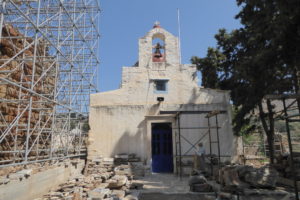
I went through the gate and up to the shed. Inside were two men and a woman gathered around an enormous block of stone. I was taken by surprise when the lady archaeologist, who was clearly the boss, said I could take some photographs from just outside their shed but that I should venture no closer to the tower because of the many dangers on the site. “My name is Eleni. You can stay and watch us if you wish but I can’t talk to you now because we are at a very critical point in restoring this stone.”
For half an hour they worked and I watched. A stone some 1.5 metres high, half a metre deep and a metre wide was on a wooden base and around it were the straps of a block and tackle system for lifting and manoeuvring the massive stone.
They were a well-practised team and each seemed to know instinctively what the others were about to do and what was expected on his or her part.
I later found out that they’d been working on the stone for 3 days, ‘glueing’, or welding as the archaeologist termed it, the pieces back together that had been shattered by one of the collapses. The ‘glue’ looked to be some kind of epoxy resin, white in colour, that showed where the pieces had been joined. Once the glue is applied, the team have a limited amount of time to minutely adjust the joint before the resin sets. I could now see the source of the ‘clacking‘ I’d heard from outside. The stone would be gingerly lifted until it was no more than perhaps a centimetre off the base. A wooden mallet would then be used to displace one section of the stone by just a fraction of a millimetre at a time – ‘clack, clack, clack‘. The stone would be lowered again and the alignment checked with some form of caliper gauge. This process was repeated until the team were happy that the latest weld was perfect. Then, another time-critical operation – the excess resin had to be laboriously cleaned away before it set, leaving as tidy and invisible a joint as possible.
The time I spent watching was just the end process of this one joint, and, on this and other stones, there would be more joins to be made. Unfortunately, I was too late to see the two separate pieces of this stone being put together, although I suspect that in itself takes many hours before the resin can finally be applied and the ‘clacking‘ and checking iteration can be started – which is where I came in.
It seems counter-intuitive that working on such massive stones requires something akin to the skill and precision of a watchmaker, while at the same time, huge amounts of strength are required to man-handle the enormous, heavy chunks of rock. How the ancients built such an impressive and advanced structure almost 2500 years ago defies imagination.
Satisfied with their work, the team left the joint to set and Eleni, the archaeologist, had time to speak to me. She was absolutely charming and took me on a tour of the site allowing me to take as many pictures as I wanted on the condition that nothing is published until the work is completed because of potential issues with ‘the Ministry’. I agreed to this ’embargo’ and wrote this blog with a view to posting it at a later date.
The work of welding the stones back together is only a part of the skilled work of an archaeologist like Eleni. When parts of the tower collapsed, unfortunately the stones didn’t just fall on the ground waiting to be picked up and put back in place in some later decade or century. They shattered into many pieces. Some of these pieces remain in situ but some were ‘robbed’ for ‘recycling’ by locals – even by kings!
The initial amazing skill of the restorer is to study the pile of broken and incomplete pieces to try to envisage which pieces fit together to make a whole stone. The next step is to determine where in the original structure that once-complete stone would have been placed. It’s a three dimensional, monochrome jigsaw puzzle on two levels – and no one has the jigsaw box top to guide them! Unlike a jigsaw puzzle, you can’t easily pick up such a massive stone and see if it fits – “Here – no – what about here? – no – let’s try here . . .”
No wonder each member of the team has its own favourite reconstructed stone – one that has tested their 3-dimensional skills of imagination, their strength in dealing with it, their stamina and persistence over the long process of reconstructing it and their love of the colour and texture of the material. Each stone takes on almost a living personality. Grigoris jokes that his favourite stone is number 30 – the same age as his ideal woman! Eleni is probably relieved that, at 33, she fails to meet Grigoris’ strict selection criteria. Nikos is less forthcoming – I sense he has an equal passion for all the stones.
“This is my favourite,” says Eleni, showing me stone number 34. “It took us 3 months to weld it back together. I’m going to write my name on it before we lift in back into place.” Let’s hope that some regal visitor to the tower, in centuries to come, doesn’t take an instant liking to Eleni’s inscription!
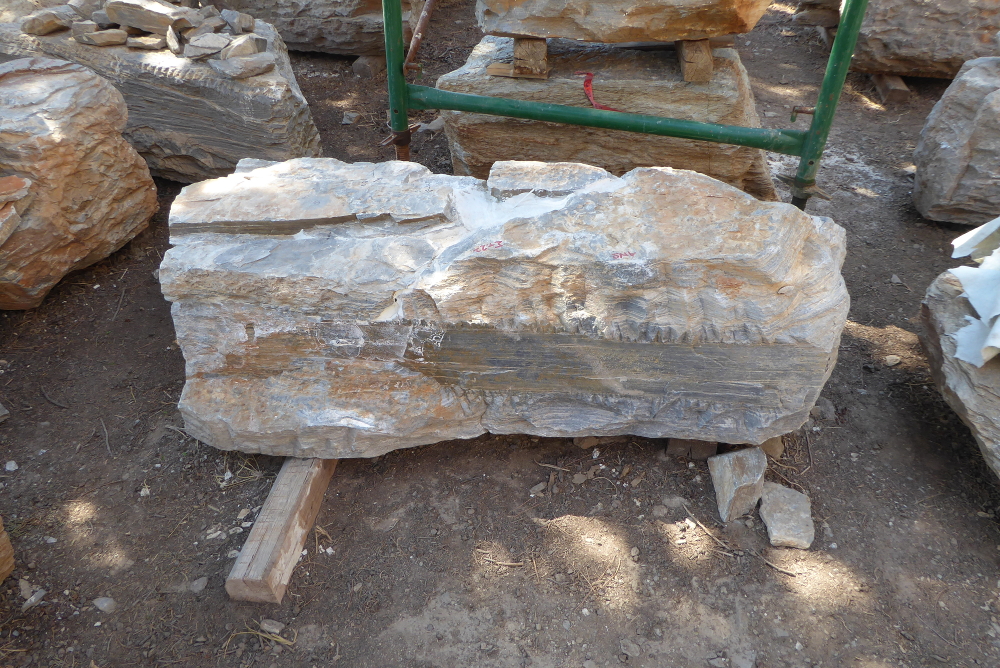
While Nikos moved materials around in his Lamborghini tractor, expertly negotiating it through the narrow archway entrance to the courtyard, Grigoris cleaned up and disappeared off on a secret mission.
“You must join us for lunch,” insisted Eleni, as Grigoris reappeared carrying tomatoes and small cucumbers. “We planted them in the grounds when we first started work on the tower and now we have a constant fresh supply for our lunch every day.”
Grigoris poured water on the workbench in the courtyard and gave it a scrub before up-ending the bench to let the water cascade off and all four of us sat round the improvised dining table. “We have to be sparing with the water, there is no supply here so it has to be brought in to fill the tank over there.” Eleni pointed. “We use a lot of water for the cleaning of the stones after the welding.”
“I prepared some aubergine with pasta last night, would you like some?” As Eleni served the pasta, Grigoris prepared the salad. Those big hands that made light work of the huge stones were equally dexterous expertly slicing the cucumber and tomato, holding each in one hand and the small knife in the other – no chopping board or plate required – I’d have lost a finger or two, but Grigoris knew what he was doing.
Eleni fetched the wine. “Yeia mas” we all said as we chinked glasses. Eleni handed me some bread. “Try some of this, we have it at special times.” It was denser and darker than the normal Greek bread and had a hint of aniseed.
The pasta was excellent and Grigoris’ salad, liberally laced with the greenest of olive oils, was the best I’ve ever tasted. A soft, salami-like sausage appeared and slices landed on my plate. Every time I finished the olives, more would appear and Grigoris must have noticed my liking for the oil – as I mopped it up with the bread he’d lean across with the bottle and drizzle more on the plate. “The olives are Grigoris’ own.” Eleni explained “He marinates them in brine after he picks them.”
Freshly picked, foraged figs rounded off this surprise gourmet lunch. “You mustn’t eat the skin” shrieked Eleni. I explained that I always hold them by the pointed end and eat everything up to the stem – skin and all. “We only eat the inside. These are OK because there are no insecticides used on them but with others you never know.” she said.
It really was one of the best Greek lunches I’ve ever had and the conversation flowed so easily. I told them about Bents’ visit to the tower and promised to email her that section of the book.
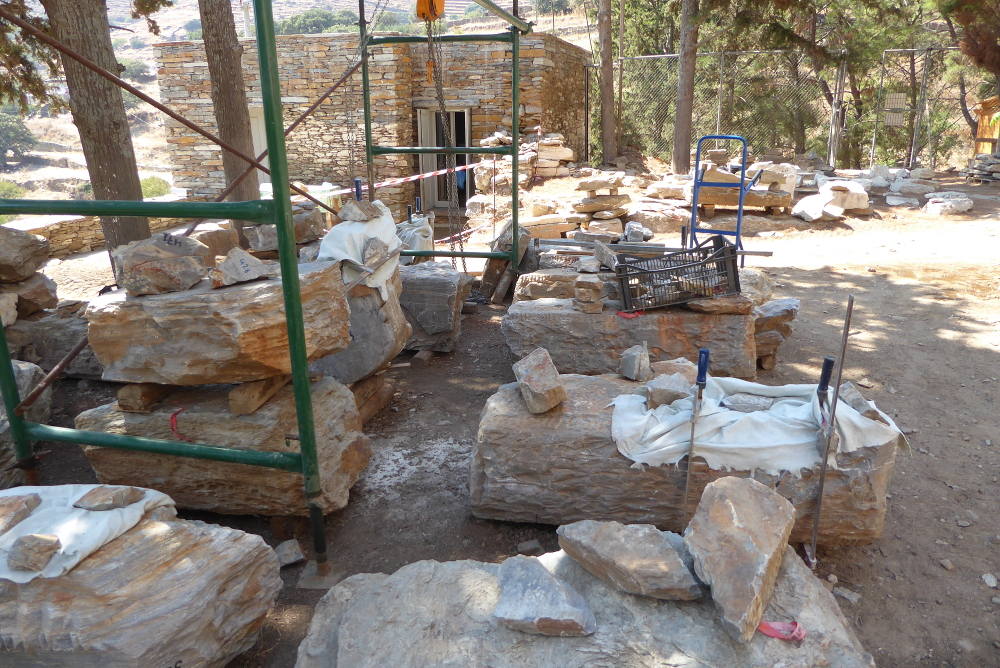
We discussed the restoration of the tower and the problem of funding. The first tranche of the funding is due to run out by December 2015 and, if further money is not forthcoming, the group will break up and move on to other things. This would be a tragedy for such a tightly-knit team.
“Ironically,” Eleni told me, “the economic crisis had been good in one respect for the restoration project. Before the downturn, Grigoris’ and Nikos’ skills as stone masons had been in high demand, as mainland and Athenian Greeks had commissioned new houses to be built in the traditional style. The restoration project would have struggled to employ them at their former market rates.”
Fortunately for both, their skills will always be in demand and, if all else fails, Grigoris’ talents as a chef and olive oil producer should see him through!
I said my goodbyes and, as I continued on my journey down to Poisses, I wondered whether there was something special about that tower which, despite its fallen and shattered stones, was still contagiously radiating that essential Greek spirit of filoxenia, even 130 years after the Bents themselves experienced it.
